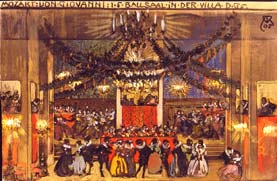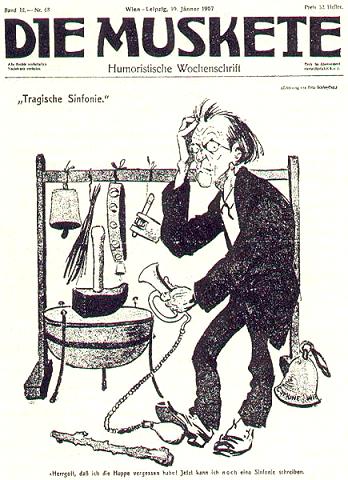 |
|||
|

|
|
First performance on May 27, 1906 in Essen
In the year 1903, the beginning of Mahler's work on the Sixth Symphony, started
also the zenith of his career at the Vienna Opera which should last until 1906. Not only by the help
of his wife Alma, Mahler had got in touch with the Vienna Secession, and he had recognised how
important its arts and artists would be for the development of the opera. In cooperation with one of
the Secession's founders, the painting, graphic and stage designing artist
Alfred Roller (1864-1935), Mahler succeeded
to create sensational performances harmonizing music, light, form and colour, thus unifying theatre
and opera in the sense of the idea of the all-embracing work of art, an undertaking which for us
nowadays is rather self-evident but then and especially in Vienna loving the tradition, it was
revolutionary. Besides Wagner's works and sensational new productions like Beethoven's Fidelio
(1904) or Gluck's Iphigenia at Aulis (1907), Mahler did a great service regarding new
interpretations of Mozart's operas. But this way to revolutionize the opera stage also gave rise to
criticism of the Vienna traditionalists who at the same time reproached him to neglect on one hand
contemporary composers and on the other hand the direction of the Vienna Opera by travelling around
too much in order to perform concerts elsewhere, not to speak of the Vienna press anyway not very kind
towards jews and starting now to be more hostile to Mahler even if it still took until 1907 before a
real press campaign aiming to bring him down began. "The Sixth is a work of a fundamentally pessimistic basis, its principal character
comes from the bitter taste in life's potion, it says an emphatic No and says it especially in its
last movement where the inexorability of the battle of all against all seems to have become music." By looking from outside, just formally, the middle one of the three purely instrumental
symphonies 5 to 7 is the most conventional one of all Mahler symphonies: It consists of the traditional
four movements, an Allegro in sonata form, a Scherzo, a slow movement, the Andante, and the Finale in
sonata form as well. Three of the four movements are in the key of a minor and the symphony begins
and ends in the same key. However, it is already therefore that it is an unusual Mahler symphony since
it is the only one following the forms of the classic symphony; all other symphonies with four
movements differ from the traditional structures. "But the contents put by Mahler into the old
structure of the movements has nothing to do anymore with its sense and character. One could even say
that by composing the Sixth, the composer has gone as far as possible away from the traditional way of
making music. The Sixth is his most radical symphony." (Heinrich Kralik)
But the orchestration is not traditional at all: The number of wind instruments
is considerably reinforced thus emphasizing the march rhythm of the symphony: Up to five flutes, four
oboes and an English horn, five clarinets, five bassoons, eight horns, six trumpets, four trombones
and the tuba lend an outstanding weight to the wind instruments thus often thrusting the strings into
the background which is also underlined by the strong presence of percussion instruments such as
timpani, glockenspiel, bass and side drums, triangle, cymbal, tamtam, slapstick and switch; they are
completed by deep bells and - for the first time - cowbells and a hammer. Mahler is supposed to have
said about the cowbells that they are the last sound to be heard from the earth by the lonely in the
extremest height: A symbol of total loneliness. The three hammer strokes, "short, powerful, but dully
reverberating in a non-metallic way" (Mahler), according to Alma Mahler are symbols of three great
blows of fate in Mahler's life hereby anticipated. The Sixth Symphony is maybe the greatest enigma Mahler has left; beyond the technical
structure, it refuses to be interpreted or explained in any way by all Mahler admirers whose
explanations therefore are as much different as their number is multiple. More than usual, listeners
should therefore just let the language of the music have their effects on them without any reservation
and let their own images develop before their inner eye. The first movement is determined by a heavy, sometimes menacing march, going forward unstoppably and ending in a cry of despair before a second, lovely theme is heard, in the same rhythm first, increasing afterwards up to an extreme intimacy but without really losing the march character. Here, surprisingly and for the only time, Mahler prescribes a repetition. The march restarts, more martially than before, resisted by a soft longing motif but which is countered by strange and bizarre trills and carried away by the steady rhythm until reaching a final point where the flowing stops completely; here, for the first time, the cowbells are heard to tell us that we have reached the summit and make us feel the loneliness. A lyric and devoted phrase is introduced by the bass clarinet, and I imagine the complete loneliness of a high mountain region in the light of the full moon. A calm and peaceful atmosphere arises. But suddenly, the march restarts again, taking us away from this wonderful place. Through the second theme, within the reprise, the movement pretends to reach a relaxed climax and ends abruptly. The second movement is a Scherzo in a minor and has a clear structure with two trios. After a tumultuous beginning continuing without rupture the march rhythm of the first movement, we find again - like in the first four symphonies - ironic accents by quacking sounds (throughout the whole movement) and bizarre trills of the wind instruments. Then follows a trio in the "altväterisch" (old-fashioned) style which in its exaggerated attitude of parody reminds me on the Glissandi of the second movement of the Second Symphony. The entire Scherzo has again the effect of being grotesque but in the principal motif, a tragic undertone is always heard. At the end of the movement, the music slows down like an old steam engine braking more and more before finally stopping completely. Bruno Walter wrote about the Seventh Symphony as follows: "... the third (middle movement) as a piece of music (is) maybe the most beautiful Mahler has ever written: there is a sweet tender erotism living inside which is the only erotic sound in Mahler's work as far as I know." Certainly, every human being has erotic feelings with different music - I rather tend to call the Second Night Music the most romantic one Mahler has ever written, underlined by the above mentioned orchestration with guitar and mandoline. I feel sweet and tender erotism within the following third movement of the Sixth Symphony: Never Mahler has written a more restrained, more tender, more longing and at the same time more desiring music. Most intimate motifs flow one into the other and beside each other in an expressive art of counterpoint and permanent changing of keys until the most unusual, most tender climax to be found in Mahler's music: Violas, harp, celesta and finally the single Glissando of the violins float in the highest spheric lightness seeming to hold the breath and the course of the world - but yearningly, the oboe picks up the theme again, the rescueing relaxation does not take place. Completely unexpected follows the changing into a triumphant e major, the second climax accompanied by fanfares of the horns and sounds of the cowbells: The music increases up to giddy heights until the point where, after the return of a brightly glistening e flat major, complete happiness and final apotheosis seem to be reached; but the excitement decreases nearly as suddenly as it had begun and all that is left is a longing sigh of the clarinet, carried further by the flute, tenderly accompanied by the harp and softly terminated by the cellos. A furiously rising introduction in the key of c minor starts the monumental fourth movement in which the whole force of this outsized orchestra unfolds. By changing into the main key of a minor and the restart of the march rhythm, the themes of this movement in sonata form are introduced; the introduction will come back again at the beginning of the development, the reprise and the coda. Out of the cowbell sounds, out of the loneliness, a doubtful optimism arises as well as the restrainedly joyful expectancy that all will turn into a happy ending; the character of steadily walking forward which is typical for the whole symphony is found in this movement with particular clearness but every time when the summit, the salvation, seems to be reached, all hope is destroyed by an enormous hammer stroke and everything breaks in a tragic way. The music is torn between hope and destruction and the final climax before the coda in the key of a major, a key whose usually brightly shining sound colour this time nearly sounds shrill, collapses weakly. With difficulty, the music struggles to its feet again and drags on to the final minor chord which leaves us helpless, hopeless, yet not unfulfilled. |
||||||||

